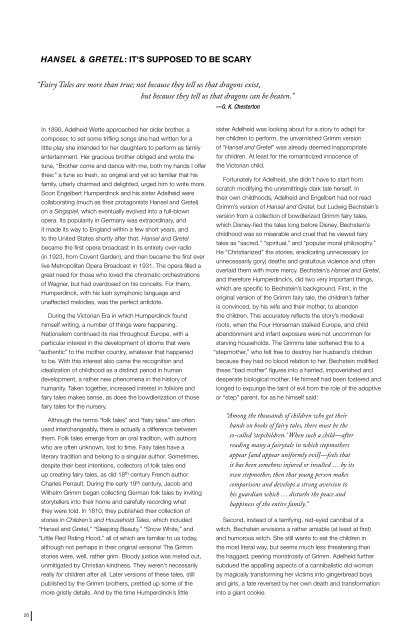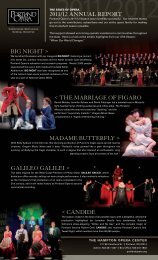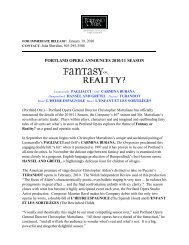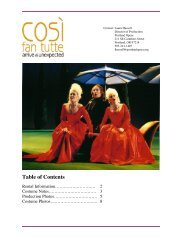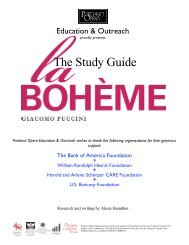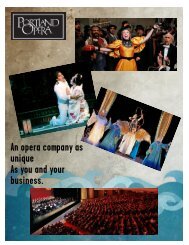christopher mattaliano - Portland Opera
christopher mattaliano - Portland Opera
christopher mattaliano - Portland Opera
Create successful ePaper yourself
Turn your PDF publications into a flip-book with our unique Google optimized e-Paper software.
Hansel & Gretel: It's Supposed to be scary<br />
“Fairy Tales are more than true; not because they tell us that dragons exist,<br />
but because they tell us that dragons can be beaten.”<br />
—G. K. Chesterton<br />
In 1890, Adelheid Wette approached her older brother, a<br />
composer, to set some trifling songs she had written for a<br />
little play she intended for her daughters to perform as family<br />
entertainment. Her gracious brother obliged and wrote the<br />
tune, “Brother come and dance with me, both my hands I offer<br />
thee:” a tune so fresh, so original and yet so familiar that his<br />
family, utterly charmed and delighted, urged him to write more.<br />
Soon Engelbert Humperdinck and his sister Adelheid were<br />
collaborating (much as their protagonists Hansel and Gretel)<br />
on a Singspiel, which eventually evolved into a full-blown<br />
opera. Its popularity in Germany was extraordinary, and<br />
it made its way to England within a few short years, and<br />
to the United States shortly after that. Hansel and Gretel<br />
became the first opera broadcast in its entirety over radio<br />
(in 1923, from Covent Garden), and then became the first ever<br />
live Metropolitan <strong>Opera</strong> Broadcast in 1931. The opera filled a<br />
great need for those who loved the chromatic orchestrations<br />
of Wagner, but had overdosed on his conceits. For them,<br />
Humperdinck, with his lush symphonic language and<br />
unaffected melodies, was the perfect antidote.<br />
During the Victorian Era in which Humperdinck found<br />
himself writing, a number of things were happening.<br />
Nationalism continued its rise throughout Europe, with a<br />
particular interest in the development of idioms that were<br />
“authentic” to the mother country, whatever that happened<br />
to be. With this interest also came the recognition and<br />
idealization of childhood as a distinct period in human<br />
development, a rather new phenomena in the history of<br />
humanity. Taken together, increased interest in folklore and<br />
fairy tales makes sense, as does the bowdlerization of those<br />
fairy tales for the nursery.<br />
Although the terms “folk tales” and “fairy tales” are often<br />
used interchangeably, there is actually a difference between<br />
them. Folk tales emerge from an oral tradition, with authors<br />
who are often unknown, lost to time. Fairy tales have a<br />
literary tradition and belong to a singular author. Sometimes,<br />
despite their best intentions, collectors of folk tales end<br />
up creating fairy tales, as did 18 th century French author<br />
Charles Perrault. During the early 19 th century, Jacob and<br />
Wilhelm Grimm began collecting German folk tales by inviting<br />
storytellers into their home and carefully recording what<br />
they were told. In 1810, they published their collection of<br />
stories in Children’s and Household Tales, which included<br />
“Hansel and Gretel,” “Sleeping Beauty,” “Snow White,” and<br />
“Little Red Riding Hood,” all of which are familiar to us today,<br />
although not perhaps in their original versions! The Grimm<br />
stories were, well, rather grim. Bloody justice was meted out,<br />
unmitigated by Christian kindness. They weren’t necessarily<br />
really for children after all. Later versions of these tales, still<br />
published by the Grimm brothers, prettied up some of the<br />
more gristly details. And by the time Humperdinck’s little<br />
sister Adelheid was looking about for a story to adapt for<br />
her children to perform, the unvarnished Grimm version<br />
of “Hansel and Gretel” was already deemed inappropriate<br />
for children. At least for the romanticized innocence of<br />
the Victorian child.<br />
Fortunately for Adelheid, she didn’t have to start from<br />
scratch modifying the unremittingly dark tale herself. In<br />
their own childhoods, Adelheid and Engelbert had not read<br />
Grimm’s version of Hansel and Gretel, but Ludwig Bechstein’s<br />
version from a collection of bowdlerized Grimm fairy tales,<br />
which Disney-fied the tales long before Disney. Bechstein’s<br />
childhood was so miserable and cruel that he viewed fairy<br />
tales as “sacred,” “spiritual,” and “popular moral philosophy.”<br />
He “Christianized” the stories, eradicating unnecessary (or<br />
unnecessarily gory) deaths and gratuitous violence and often<br />
overlaid them with more mercy. Bechstein’s Hansel and Gretel,<br />
and therefore Humperdinck’s, did two very important things,<br />
which are specific to Bechstein’s background. First, in the<br />
original version of the Grimm fairy tale, the children’s father<br />
is convinced, by his wife and their mother, to abandon<br />
the children. This accurately reflects the story’s medieval<br />
roots, when the Four Horseman stalked Europe, and child<br />
abandonment and infant exposure were not uncommon for<br />
starving households. The Grimms later softened this to a<br />
“stepmother,” who felt free to destroy her husband’s children<br />
because they had no blood relation to her. Bechstein mollified<br />
these “bad mother” figures into a harried, impoverished and<br />
desperate biological mother. He himself had been fostered and<br />
longed to expunge the taint of evil from the role of the adoptive<br />
or “step” parent, for as he himself said:<br />
“Among the thousands of children who get their<br />
hands on books of fairy tales, there must be the<br />
so-called ‘stepchildren.’ When such a child—after<br />
reading many a fairytale in which stepmothers<br />
appear [and appear uniformly evil]—feels that<br />
it has been somehow injured or insulted … by its<br />
own stepmother, then that young person makes<br />
comparisons and develops a strong aversion to<br />
his guardian which … disturbs the peace and<br />
happiness of the entire family.”<br />
Second, instead of a terrifying, red-eyed cannibal of a<br />
witch, Bechstein envisions a rather amiable (at least at first)<br />
and humorous witch. She still wants to eat the children in<br />
the most literal way, but seems much less threatening than<br />
the haggard, peering monstrosity of Grimm. Adelheid further<br />
subdued the appalling aspects of a cannibalistic old woman<br />
by magically transforming her victims into gingerbread boys<br />
and girls, a fate reversed by her own death and transformation<br />
into a giant cookie.<br />
20


